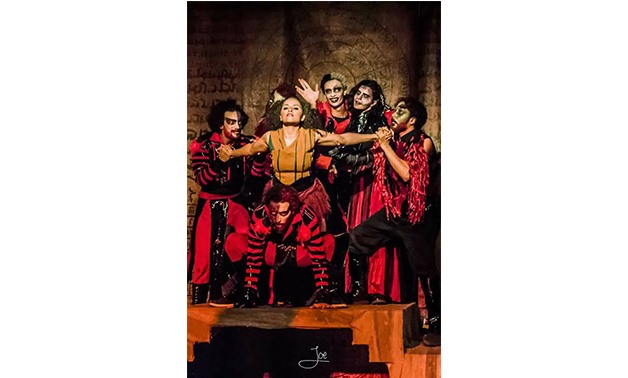
Scene from “The Session” (Photo courtesy of “The Session’s” official Facebook page)
CAIRO – 6 November 2017: Being touched by a demon is a theme that has existed over the years in almost all human cultures and societies. Director and writer Monadel Antar wrote a daring play “The Session,” which deals specifically with this phenomenon in a performance where Antar used dazzling techniques of movement, light, and clothing to tackle the idea with a distinguishable perspective.
The script has many weaknesses but it is balanced by the great effort put into the performance from all its actors.
“The Session” is performed on Taliaa Theater.
Antar's inspiration came from the story of Mary Magdalene in the Bible and the inherited old stories. “It is just a theatrical view for an idea that is believed by many in this world,” he said.
The story lines are simple, the demon touchs a girl from Mary Magdalene’s descendants, a sheikh and priest do their best to fight the demon and exorcise him out of the young girl’s body.
The interaction between the world of humans and the world of demons exposes both worlds to the audience in a subtle way. The fight carries on until the end of the performance where the girl kills herself; Lucifer did not lose! Such an ending is so rare in Egyptian theatrical drama. Antar did not give us a happy ending; on the contrary, evil actually won and good (man) was the victim.
The Biblical story is that Jesus cured Mary Magdalene from seven demons and as a result she believed in him. That is why the writer chose a fictional descendant of that Christian figure to be touched by Lucifer himself – performed brilliantly by Taha Khalifa.
The main weakness of the play is that the writer handled the issue through the eyes of Islam and Christianity only since they are the official religions in Egypt and did delve deep into Egyptian popular beliefs and superstitions.
That is not to mention that the struggle between evil and good is much older than the story of Mary Magdalene, and the direct preaching used by the devil, the sheikh and the priest is a naive technique that was balanced by the capable rendering of the young demons, the body movement and the mystical decoration of the performance hall.
The play begins with actors humming and rumbling in undistinguished words to prepare the audience before entering into a different, ambiguous parallel universe. The accompanying music adds to this atmosphere. The dancing of the demons demonstrates high fitness, where dancers execute unusual movements fit for devils.
The make-up artist was innovative especially when dealing with Lucifer and his followers, to the point that we really cannot distinguish the real faces of the actors. The light dominated by the green, blue and red was traditional in enforcing the concept that demons live in underground caves or isolated in unknown areas in the universe.
The play with its unusual ending gives the message that having faith in God requires a parallel belief in the Devil as well. Lucifer declares that in clear words, which leaves with the audience something to think about as they exit the theatre.
It also portrays how the Egyptian society often believes that a demonic power has control over their lives which in return can be thought of as a non-logical rhetoric that they suffer from.
The script is uncommon, non-traditional and performed by a group of very promising actors. In spite of its weaknesses, the play is a shining example that Egyptian theater is not dead and that it is still creative.
Comments
Leave a Comment